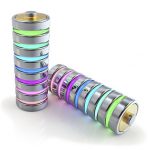 Experienced jewelers and manufacturers know that typical “cold soldering” is more accurately described as “resistance soldering.” Cold soldering tools, like the popular ColdHeat Soldering Pen, have a split tip with electric current running through each point. When the tips are touched to solder, the probes and the solder heat up very quickly because of their resistance to the current passing through them. Lifting the tips away from the solder breaks the circuit, and everything quickly cools.
Experienced jewelers and manufacturers know that typical “cold soldering” is more accurately described as “resistance soldering.” Cold soldering tools, like the popular ColdHeat Soldering Pen, have a split tip with electric current running through each point. When the tips are touched to solder, the probes and the solder heat up very quickly because of their resistance to the current passing through them. Lifting the tips away from the solder breaks the circuit, and everything quickly cools.
Now, what if you could use a similar technique on any metal – even ones with very high melting points like gold? Materials scientists at Iowa State University may have just revolutionized the manufacturing industry by developing a soldering method that requires no heat or electricity. It works by forming a shell around microscopic metal droplets and keeping them in a liquid state – even when their surroundings are cooler than their melting temperature – until the shell is ruptured, causing the metal to flow and solidify, like solder.
These droplets are made possible with supercooling – the process of lowering the temperature of a liquid below its freezing point without it becoming a solid. When a liquid falls below its freezing point, it begins to crystalize in the presence of a “seed crystal” or nucleation site, around which a crystal structure can form, creating a solid – almost like how synthetic sapphires are made. Without this seed, the liquid’s atomic structure cannot crystalize and become a solid – even if the temperature continues to fall below the freezing point.
Solid metals have a crystalline structure, so melted metal is subject to the physics of supercooling. The researchers at ISU created the above mentioned droplets by whipping molten metal into a froth, then allowing it to cool gradually. Oxygen in the froth causes the very outsides of droplets to form a thin metal oxide shell. This oxide reacts with acetic acid, forming a smooth oxide-acetate shell that allows the core to stay liquid as it cools. This ultrathin shell prevents the liquid metal from coming in contact with nucleation sites needed to trigger solidification. Rupturing the shells causes the liquid to flow and immediately solidify, bonding surfaces together – kind of like a water balloon filed with super glue. In a demonstration, the researchers used the technique to solder a gold wire to a sheet of gold film, repair holes in silver film and bond sheets of foil together.
Lead researcher, Martin Thuo, has already formed a start-up company, Safi-Tech, to commercialize this technology. Not only does it have the potential to make jewelry repairs easier, it could also revolutionize metal repair, metal casting, and even 3D printing. Perhaps in the future, we’ll be selling these droplets alongside our selection of casting grains.











